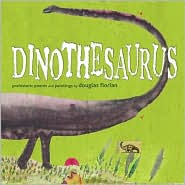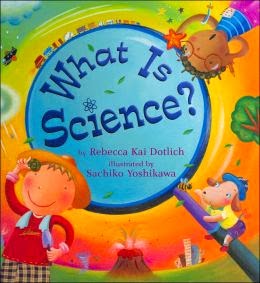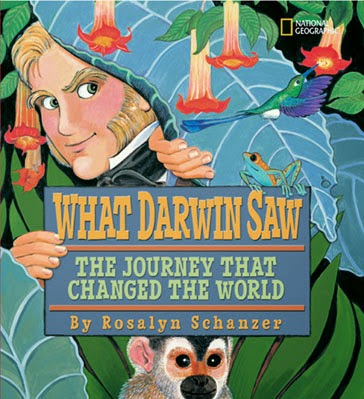What is it about dinosaurs that so captures the attention of children and adults alike? Is it their size and the fact that so many grew to be so very large? Is it the mystery of their extinction? I suppose for me the interest comes from the fact that every time a new skeleton, nest, or coprolite is unearthed our ideas change and are challenged as we learn something new.
Today's pairing celebrates of our longstanding fascination with dinosaurs.
Poetry Book
 Dinothesaurus: Prehistoric Poems and Paintings, written and illustrated by Douglas Florian, is a collection of 20 poems chock full of information about dinosaurs. Each double page spread contains an illustration and a poem. The illustrations were done with gouache, collage, colored pencils, stencils, dinosaur dust, and rubber stamps on primed brown paper bags and are full of interesting little tidbits. For example, the pages for the poem Iguanodon has a female dinosaur (Iguano-Donna) who is wearing bracelets and a pearl necklace. Before, during, and after reading the accompanying poems they beg to be looked over carefully. The poems themselves are laced with puns, word play, and made-up words. A pronunciation guide for each dinosaur name and the name’s meaning are included below each title. Here's an example.
Dinothesaurus: Prehistoric Poems and Paintings, written and illustrated by Douglas Florian, is a collection of 20 poems chock full of information about dinosaurs. Each double page spread contains an illustration and a poem. The illustrations were done with gouache, collage, colored pencils, stencils, dinosaur dust, and rubber stamps on primed brown paper bags and are full of interesting little tidbits. For example, the pages for the poem Iguanodon has a female dinosaur (Iguano-Donna) who is wearing bracelets and a pearl necklace. Before, during, and after reading the accompanying poems they beg to be looked over carefully. The poems themselves are laced with puns, word play, and made-up words. A pronunciation guide for each dinosaur name and the name’s meaning are included below each title. Here's an example.PterosaursYou can check out some of the artwork and read additional poems from the book at Florian Cafe.
TERR-oh-sawrs (winged lizards)
The pterrifying pterosaurs
Flew ptours the ptime of dinosaurs.
With widespread wings and pteeth pto ptear,
The pterrorized the pteeming air.
They were not ptame.
They were ptenacious--
From the Ptriassic
Pto the Cretaceous.
Poem ©Douglas Florian. All rights reserved.
Nonfiction Picture Book
 Born to Be Giants: How Baby Dinosaurs Grew to Rule the World, written and illustrated by Lita Judge explores how dinosaurs hatched from eggs grew and survived to become some of the largest creatures that ever walked the earth. The watercolor illustrations do a fine job of depicting these beasts, giving readers a clear sense of what they may have looked like, what their coloration may have been, and how their nests may have been constructed.
Born to Be Giants: How Baby Dinosaurs Grew to Rule the World, written and illustrated by Lita Judge explores how dinosaurs hatched from eggs grew and survived to become some of the largest creatures that ever walked the earth. The watercolor illustrations do a fine job of depicting these beasts, giving readers a clear sense of what they may have looked like, what their coloration may have been, and how their nests may have been constructed.Judge uses evidence discovered by paleontologists and uses that information to hypothesize how dinosaurs may have behaved. She also describes dinosaurs by making comparisons to living animals. Here's an excerpt that shows just how deftly she combines these two approaches.
Some plant-eating dinosaurs kept their nests safe by grouping into large colonies. Over a thousand fossilized nests of HYPACROSAURUS, a duck-billed dinosaur, were found in one area!There are many comparisons to modern-day birds here, and given the view that some species of dinosaurs may have evolved to become today's birds, these are reasonable comparisons to draw.
Penguins, pelicans, and many seabirds gather at huge nesting sites today. The nests are clustered with just enough space to fit babies and adults. The parents work together, alerting each other if a predator comes near.
Judge doesn't shy away from difficult vocabulary in the text, using words like altricial and precocial. However, readers are supported in understanding these words through simple, explanatory sentences, as well as the inclusion of a glossary. Here's an example.
Most bird species today are altricial. Their babies are helpless when they hatch, with wobbly, undeveloped legs and weak necks. The hatchlings must stay in the nest until they grow stronger and older. It is likely that Maiasaura were altricial—like robins today.Eight species of dinosaur are explored in the book. Early on readers are introduced to Argentinosaurus, a dinosaur that likely weighed as much as 17 elephants. Imagine for a moment just how large this dinosaur must have been. Now juxtapose this with the knowledge that the largest dinosaur eggs ever found were only 18 inches long. As Judge tells readers, "These mothers probably couldn't protect their tiny babies without trampling them underfoot." Judge continues:
A herd of Argentinosaurus was an earth-shaking, bone crushing stampede of feet. Their tiny babies probably hid under forest cover. Hungry, meat-eating dinosaurs stalked them for a bite-sized meal. Huge crocodiles ate them. Even little mammals ate them. The babies were hungry all the time and had to find their next meal without becoming one! Only a few survived.Dinosaurs may have been giants, but surviving to adulthood was no easy task. The text leaves readers much to ponder while also providing a wealth of factual information. There are some brief notes in the back matter about each of the dinosaur species, including pronunciation (always important with dinosaur names), approximate size, location of fossils, and period of appearance.
Perfect Together
While Florian's pomes may be whimsical, they do open up insights into dinosaurs and can raise questions for readers. A good question to ask is, "Do you think that's true?" Together you can look for those answers, some of which may come from Judge's book.
For additional resources, consider these sites.
One Additional Book
 If you want to combine your exploration of dinosaurs with ideas about the nature of science, considering adding this wonderful book.
If you want to combine your exploration of dinosaurs with ideas about the nature of science, considering adding this wonderful book.
- Learn all about Sue at The Field Museum. (You DO know who Sue is, right?)
- The Dinosauria at the University of California Museum of Paleontology has a wealth of information about dinosaurs and the fossil record.
- The Smithsonian Museum of Natural History has a dinosaur site with a great deal of information and interactive resources.
- BBC Nature Prehistoric Life is the companion to a number of BBC shows. You'll find a wealth of information here.
- The Natural History Museum (UK) has a great dinosaur site for kids.
- The Scholastic teachers site has an interactive whiteboard ready guide to dinosaurs that is packed with materials for students and teachers.
One Additional Book
 If you want to combine your exploration of dinosaurs with ideas about the nature of science, considering adding this wonderful book.
If you want to combine your exploration of dinosaurs with ideas about the nature of science, considering adding this wonderful book.Boy, Were We Wrong About Dinosaurs!, written by Kathleen Kudlinski and illustrated by S.D. Schindler, not only describes our changing ideas about dinosaurs, but also makes it clear to readers that as more evidence is unearthed, our ideas are likely to change again. Readers will enjoy looking at the illustrations that compare "old" ideas about the way dinosaurs looked to the views held today, and will marvel at the images of dinosaurs with feathers. This is a great introduction to dinosaurs and a wonderful treatment of the work scientists do as they work to expand our understanding of the world.
0 Comments on Science Poetry Pairings - Dinosaurs as of 4/6/2014 1:15:00 AM
Add a Comment















